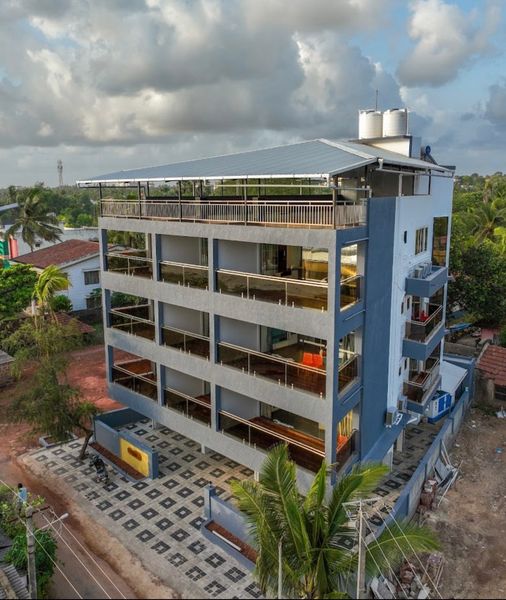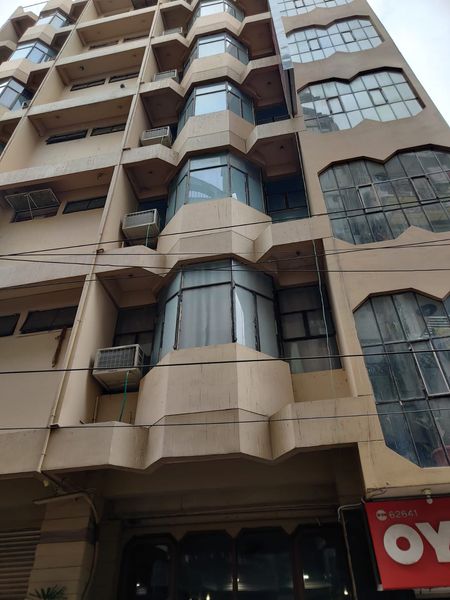Dwarkadhish Temple: A Spiritual Journey through Gujarat’s Sacred Landmark
 Shivam Kumar
12 Nov, 2024
12 mins read
2374
Shivam Kumar
12 Nov, 2024
12 mins read
2374

The Dwarkadhish Temple, also known as Shree Dwarkadhish Temple, stands as one of the most significant and revered temples in India. Located in the coastal town of Dwarka in Gujarat, it is dedicated to Lord Krishna, who is worshipped here as the "King of Dwarka." This temple is not only an architectural masterpiece but also holds immense spiritual value for millions of devotees across the globe. Let’s dive deeper into the temple’s rich history, cultural importance, and unique traditions.
History of Dwarkadhish Temple
Mythological Origins and Legend of Lord Krishna
The origins of Dwarkadhish Temple trace back to Hindu mythology, where it is believed that Lord Krishna, after leaving Mathura, established the kingdom of Dwarka. As the ruler, Krishna transformed Dwarka into a magnificent city, and it became one of the most prominent centers for Krishna devotion (Vaishnavism).
Ancient Construction and Timeline
Historical records suggest that the original temple was constructed around 2,500 years ago by Vajranabha, Krishna’s great-grandson. Since then, the temple has undergone numerous reconstructions due to natural disasters and invasions. The current structure, believed to date back to the 16th century, stands resiliently, reflecting centuries of devotion and faith.
Renovations Through History
Renovations over the years have preserved the temple's grandeur, keeping it intact despite the ravages of time. The structure has been maintained by various dynasties and continues to be a beacon of architectural heritage and devotion.
Significance of the Temple in Hinduism
Dwarkadhish Temple as One of the Char Dham
Dwarkadhish Temple holds a prominent position as one of the Char Dham (four major pilgrimage sites) for Hindus. The Char Dham Yatra, a sacred pilgrimage circuit, includes visits to Badrinath, Rameswaram, Puri, and Dwarka, each associated with specific deities and rituals.
Role in Krishna Devotion (Vaishnavism)
As one of the holiest temples dedicated to Lord Krishna, Dwarkadhish Temple serves as a center of Vaishnavism. It attracts millions of devotees every year, who come to pay their respects to the deity and participate in various rituals and festivals.
Location and Accessibility
Geographical Location in Dwarka, Gujarat
The temple is situated on the banks of the Gomti River, where it meets the Arabian Sea. Its location offers a breathtaking view and a sense of spiritual tranquility that draws visitors from around the world.
How to Reach the Temple (Air, Train, Road)
- By Air: The nearest airport is Jamnagar Airport, located around 137 km away. Regular flights connect Jamnagar to major Indian cities.
- By Train: Dwarka Railway Station, well-connected with major cities like Ahmedabad and Mumbai, provides a convenient travel option.
- By Road: Dwarka is accessible by state and private buses, along with taxis from nearby cities.
Architecture of Dwarkadhish Temple
Overview of the Architectural Style
The temple exemplifies traditional Hindu architecture with its five-story structure supported by 72 pillars. It showcases intricate carvings, detailed sculptures, and a grand entrance.
Main Shrine and Shikhar (Spire) Details
The main shrine, adorned with a 78-meter-high spire, is an impressive sight. The flag atop the temple, replaced five times a day, symbolizes spiritual victory and devotion to Lord Krishna.
Pillars, Sculptures, and Intricate Carvings
The temple’s intricate carvings depict scenes from Krishna’s life, mythological stories, and various deities, offering visitors a glimpse into the rich cultural and religious traditions of ancient India.
Temple Timings and Rituals
Daily Schedule and Aarti Timings
The temple opens at dawn, and the day begins with the Mangla Aarti. There are several aartis throughout the day, including Bhog, Sandhya, and Shayan Aarti, which mark different stages of worship.
Important Rituals and Ceremonies
Key rituals include the Abhishek (bathing of the deity) and various offerings, which hold immense spiritual importance. Devotees often partake in rituals to seek Krishna’s blessings.
Special Festivals and Celebrations
One of the grandest celebrations is Janmashtami, marking Lord Krishna’s birth. The temple is adorned with lights and decorations, and devotees celebrate with great enthusiasm.
Pilgrimage Significance and Devotional Practices
Activities for Pilgrims
Pilgrims often perform Parikrama (circumambulation) around the temple, chant prayers, and participate in group bhajans (devotional songs).
Spiritual Importance of Offerings and Pujas
Offerings of flowers, sweets, and fruits are made to the deity. Many devotees believe that their prayers are fulfilled by offering these items and participating in pujas.
Legends and Mythological Stories
Krishna’s Role as the King of Dwarka
The legend of Lord Krishna’s role as a king who protected his people is central to the temple’s identity. His teachings and actions as a leader are revered and form the core of many traditions.
Stories Related to Lord Krishna’s Life
From his childhood tales to his time as a warrior and protector of Dharma, Krishna’s life stories are beautifully depicted and celebrated at the temple.
Famous Festivals Celebrated at Dwarkadhish Temple
Janmashtami Celebration
The festival marking Krishna’s birth is celebrated with grandeur. Special prayers, dances, and cultural programs are held, bringing the temple alive with devotion.
Annakut Festival
This festival, celebrated after Diwali, involves offering a variety of food items to the deity as a mark of gratitude and devotion.
Ratha Yatra and Others
The annual Ratha Yatra involves pulling a chariot with Krishna’s idol, signifying his journey and connection with his devotees.
Tourist Attractions Around Dwarkadhish Temple
Gomti Ghat
Located near the temple, Gomti Ghat is where devotees take a holy dip before entering the temple.
Bet Dwarka
An island believed to have been the residence of Lord Krishna during his reign, Bet Dwarka offers spiritual and historical significance.
Rukmini Devi Temple
Dedicated to Krishna’s consort Rukmini, this temple is known for its architectural beauty and mythological importance.
The Temple's Role in Tourism and Economy
Local Economic Impact
The temple contributes significantly to the local economy through tourism, generating income for hotels, shops, and eateries.
Visitor Statistics and Trends
Millions of visitors, both domestic and international, visit each year, making it a prominent tourist attraction in Gujarat.
Cultural Practices and Traditions
Devotional Songs, Dances, and Local Customs
Devotional singing, dance performances, and rituals form an integral part of the temple’s culture, providing visitors with a rich cultural experience.
Art and Craft Around the Temple
Local artisans produce crafts and religious items, reflecting the area’s cultural heritage and traditions.
Best Time to Visit Dwarkadhish Temple
Weather Considerations
The best time to visit is between October and March when the weather is pleasant for sightseeing.
Peak Visiting Seasons
Festivals like Janmashtami and Ratha Yatra witness heavy footfall, making them an ideal time for devotees to experience the temple’s spiritual vibrance.
Travel Tips for Visitors
Dress Code and Etiquette
Modest clothing is advised. Visitors are encouraged to cover their heads during prayers as a mark of respect.
Recommended Stays and Eateries
Numerous hotels and dharmshalas offer affordable accommodation, and local eateries serve delicious Gujarati cuisine.
Preservation and Conservation Efforts
Efforts to Maintain Heritage
Various organizations and trusts work to preserve the temple’s heritage, ensuring it remains a spiritual landmark for generations to come.
Challenges Faced by Temple Management
Challenges include maintaining the structure’s integrity against natural wear and managing large crowds during festivals.
Conclusion
The Dwarkadhish Temple is not just a place of worship; it is a beacon of history, culture, and devotion. Standing tall for centuries, it continues to inspire millions with its spiritual charm and architectural brilliance. Visiting this sacred site is not just a journey; it is an experience that stays etched in one's memory forever.
FAQs
- What makes the Dwarkadhish Temple so special?
- The temple is one of the Char Dham and is dedicated to Lord Krishna, making it a major pilgrimage site with rich historical and mythological significance.
- Is there an entry fee for Dwarkadhish Temple?
- No, entry to the temple is free. However, offerings and special pujas may have charges.
- What is the best time to visit the temple?
- October to March is the ideal time due to pleasant weather and grand celebrations of key festivals.
- Are there any special rules for temple visitors?
- Yes, modest attire is recommended, and visitors should respect the customs and traditions, including maintaining silence in certain areas.
- How can I reach Dwarkadhish Temple?
- The temple is accessible via Jamnagar Airport, Dwarka Railway Station, and well-connected roadways.
Written By:
Shivam Kumar



Hotels at your convenience
Now choose your stay according to your preference. From finding a place for your dream destination or a mere weekend getaway to business accommodations or brief stay, we have got you covered. Explore hotels as per your mood.





